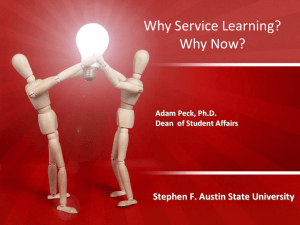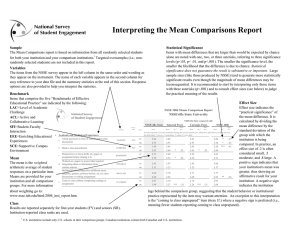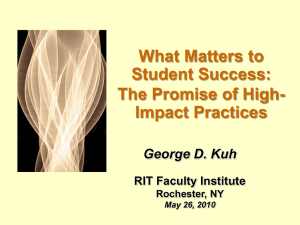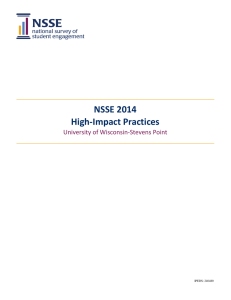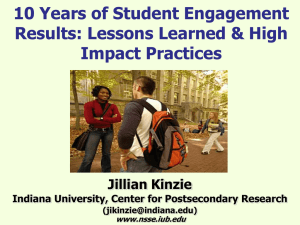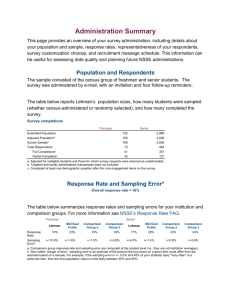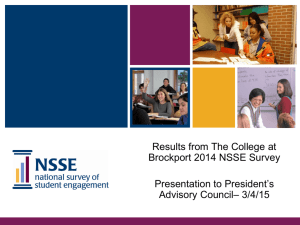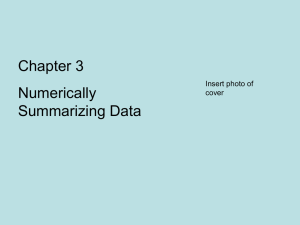NSSE 2014 High-Impact Practices Hope College IPEDS: 170301
advertisement
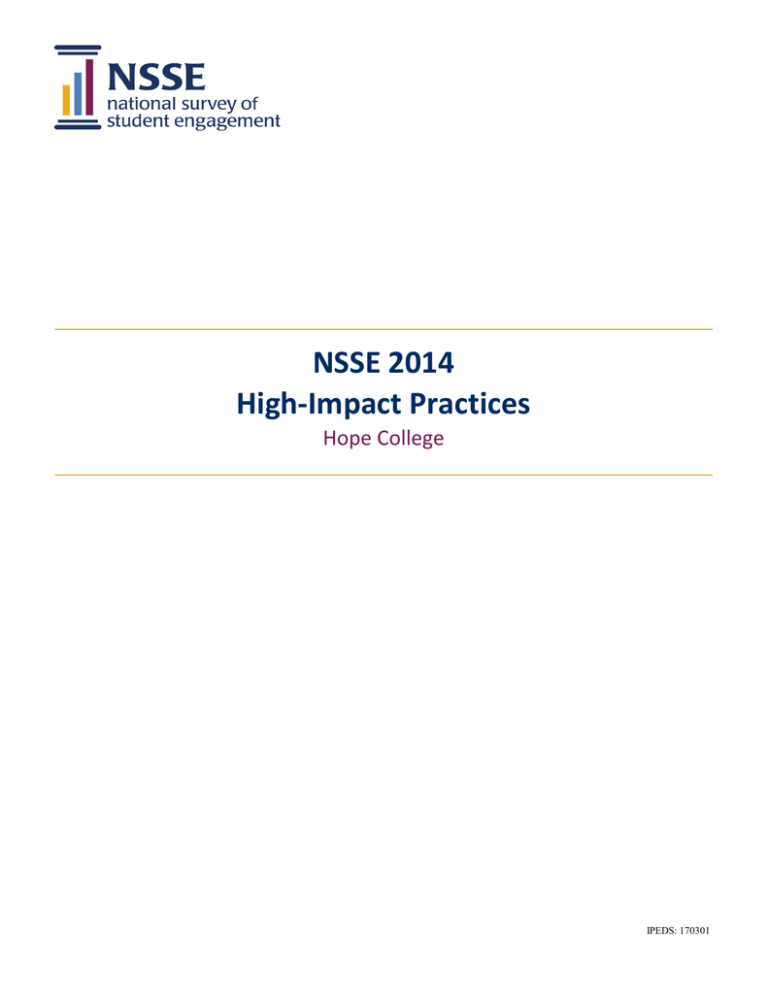
NSSE 2014 High-Impact Practices Hope College IPEDS: 170301 NSSE 2014 High-Impact Practices About This Report About Your High-Impact Practices Report Due to their positive associations with student learning and retention, certain undergraduate opportunities are designated "high-impact." High-Impact Practices (HIPs) share several traits: They demand considerable time and effort, facilitate learning outside of the classroom, require meaningful interactions with faculty and students, encourage collaboration with diverse others, and provide frequent and substantive feedback. As a result, participation in these practices can be life-changing (Kuh, 2008). NSSE founding director George Kuh recommends that institutions should aspire for all students to participate in at least two HIPs over the course of their undergraduate experience—one during the first year and one in the context of their major (NSSE, 2007). NSSE asks students about their participation in the six HIPs shown in the box at right. This report provides information on the first three for first-year students and all six for seniors. Unlike most questions on the NSSE survey, the HIP questions are not limited to the current school year. Thus, seniors' responses include participation from prior years. High-Impact Practices in NSSE ● Learning community or some other formal program where groups of students take two or more classes together ● Courses that included a community-based project (service-learning) ● Work with a faculty member on a research project ● Internship, co-op, field experience, student teaching, or clinical placement ● Study abroad ● Culminating senior experience (capstone course, senior project or thesis, comprehensive exam, portfolio, etc.) Report Sections Participation Comparisons (p. 3) Displays HIP participation for your first-year and senior students compared with that of students at your comparison group institutions. Two views present insights into your students' HIP participation: Overall HIP Participation Displays the percentage of first-year and senior students who participated in one HIP and in two or more HIPs, relative to those at your comparison group institutions. Statistical Comparisons Comparisons of participation in each HIP and overall for your first-year and senior students relative to those at comparison group institutions, with tests of significance and effect sizes (see below). Response Detail (pp. 5-7) Participation by Student Characteristics (p. 8) Provides complete response frequencies for the relevant HIP questions for your first-year and senior students and those at your comparison group institutions. Displays your students' participation in each HIP by selected student characteristics. Interpreting Comparisons The "Statistical Comparisons" section on page 3 reports both statistical significance and effect size. Effect size indicates the practical importance of an observed difference. An effect size of .2 is generally considered small, .5 medium, and .8 large. HIP participation varies more among students within an institution than it does between institutions, like many experiences and outcomes in higher education. As a result, focusing attention on overall participation rates amounts to examining the tip of the iceberg. It’s equally important to understand how student engagement (including HIP participation) varies within your institution. The table on page 8 provides an initial look at how HIP participation varies by selected student characteristics. The Report Builder—Institution Version and your Major Field Report (both to be released in the fall) offer further perspectives on internal variation and can help you investigate your students’ HIP participation in depth. Kuh, G. D. (2008). High-impact educational practices: What they are, who has access to them, and why they matter. Washington, DC: Association of American Colleges and Universities. National Survey of Student Engagement (2007). Experiences that matter: Enhancing student learning and success—Annual Report 2007. Bloomington, IN: Indiana University Center for Postsecondary Research. 2 • NSSE 2014 HIGH-IMPACT PRACTICES NSSE 2014 High-Impact Practices Participation Comparisons Hope College Overall HIP Participation The figures below display the percentage of students who participated in High-Impact Practices. Both figures include participation in a learning community, service-learning, and research with faculty. The Senior figure also includes participation in an internship or field experience, study abroad, and culminating senior experience. The first segment in each bar shows the percentage of students who participated in at least two HIPs, and the full bar (both colors) represents the percentage who participated in at least one. First-year Hope Senior 8% Great Lakes Private 11% Carnegie Class 10% NSSE 2013 & 2014 12% 0% Hope 59% 92% Great Lakes Private 50% 73% Carnegie Class 44% 25% 50% Participated in two or more HIPs 75% 11% 62% 100% 0% Participated in one HIP 18% 84% NSSE 2013 & 2014 46% 7% 25% 24% 50% Participated in two or more HIPs 75% 100% Participated in one HIP Statistical Comparisons The table below compares the percentage of your students who participated in a High-Impact Practice, including the percentage who participated overall (at least one, two or more), with those at institutions in your comparison groups. Hope Great Lakes Private Carnegie Class Effect First-year 11c. Learning Community 12. Service-Learning % % size a 9 12 -.09 63 57 .11 NSSE 2013 & 2014 Effect % 11 49 *** Effect size a % size a -.08 15 ** -.20 .28 51 *** .22 11e. Research with Faculty 8 5* Participated in at least one 67 61 * Participated in two or more 8 11 -.08 10 -.05 12 -.12 29 27 .06 29 .01 24 .11 72 69 .06 63 ** .18 61 *** .24 11e. Research with Faculty 51 29 *** .46 45 .12 24 *** .55 11a. Internship or Field Exp. 81 57 *** .53 66 *** .35 50 *** .68 11d. Study Abroad 47 20 *** .58 38 ** .18 14 *** .74 11f. Culminating Senior Exp. 80 59 *** .45 75 .12 46 *** .71 Participated in at least one 99 91 *** .43 96 ** .23 85 *** .60 Participated in two or more 92 73 *** .52 84 *** .24 62 *** .76 .11 .14 6 54 *** .07 .27 5 58 *** .09 .20 Senior 11c. Learning Community 12. Service-Learning Note. Percentage of students who responded "Done or in progress" except for service-learning which is the percentage who responded that at least "Some" courses included a community-based project. a. Cohen's h: The standardized difference between two proportions. Effect size indicates the practical importance of an observed difference. An effect size of .2 is generally considered small, .5 medium, and .8 large. *p<.05, **p<.01, ***p<.001 (z-test comparing participation rates). Note. All results weighted by institution-reported sex and enrollment status (and by institution size for comparison groups). NSSE 2014 HIGH-IMPACT PRACTICES • 3 This page intentionally left blank. 4 • NSSE 2014 HIGH-IMPACT PRACTICES NSSE 2014 High-Impact Practices Response Detail Hope College First-year Students The figures below display further details about each High-Impact Practice for your first-year students and those of your comparison groups. Learning Community Which of the following have you done or do you plan to do before you graduate? Participate in a learning community or some other formal program where groups of students take two or more classes together. Hope 9% Great Lakes Private 12% Carnegie Class 11% NSSE 2013 & 2014 19% 45% 24% 0% 36% 27% 15% 27% 35% 27% 31% 28% 25% 25% 28% 50% Done or in progress Plan to do 75% Have not decided 100% Do not plan to do Service-Learning About how many of your courses at this institution have included a community-based project (service-learning)? Hope 6% Great Lakes Private 8% Carnegie Class 6% NSSE 2013 & 2014 7% 0% 56% 37% 49% 43% 43% 51% 44% 49% 25% 50% Most or all 75% Some 100% None Research with a Faculty Member Which of the following have you done or do you plan to do before you graduate? Work with a faculty member on a research project. Hope 8% Great Lakes Private 5% Carnegie Class 6% NSSE 2013 & 2014 5% 0% 39% 37% 32% 16% 41% 43% 36% 34% 15% 38% 25% Done or in progress 22% 50% Plan to do 23% 75% Have not decided 100% Do not plan to do Note: Results weighted by institution-reported sex and enrollment status (and institutional size for comparison groups). NSSE 2014 HIGH-IMPACT PRACTICES • 5 NSSE 2014 High-Impact Practices Response Detail Hope College Seniors The figures below display further details about each High-Impact Practice for your seniors and those of your comparison groups. Learning Community Which of the following have you done or do you plan to do before you graduate? Participate in a learning community or some other formal program where groups of students take two or more classes together. Hope 29% Great Lakes Private 3%5% 27% Carnegie Class 7% 29% NSSE 2013 & 2014 24% 11% 56% 5% 9% 57% 9% 0% 63% 12% 55% 25% 50% Done or in progress Plan to do 75% Have not decided 100% Do not plan to do Service-Learning About how many of your courses at this institution have included a community-based project (service-learning)? Hope 7% 65% 10% 59% Great Lakes Private Carnegie Class 7% 56% 11% 50% NSSE 2013 & 2014 0% 28% 31% 37% 39% 25% 50% Most or all 75% Some 100% None Research with a Faculty Member Which of the following have you done or do you plan to do before you graduate? Work with a faculty member on a research project. Hope 51% Great Lakes Private 29% Carnegie Class 9% 11% 45% NSSE 2013 & 2014 24% 0% 13% Note: Results weighted by institution-reported sex and enrollment status (and institutional size for comparison groups). 7% 15% 25% 41% 48% 50% Plan to do 42% 51% 7% Done or in progress 6 • NSSE 2014 HIGH-IMPACT PRACTICES 3%5% 75% Have not decided 100% Do not plan to do NSSE 2014 High-Impact Practices Response Detail Hope College Seniors (continued) The figures below display further details about each High-Impact Practice for your seniors and those of your comparison groups. Internship or Field Experience Which of the following have you done or do you plan to do before you graduate? Participate in an internship, co-op, field experience, student teaching, or clinical placement. Hope 81% Great Lakes Private 8% 1% 10% 57% Carnegie Class 16% 66% NSSE 2013 & 2014 11% 50% 0% 23% 25% Done or in progress 6% 5% 17% 8% 50% Plan to do 20% 19% 75% Have not decided 100% Do not plan to do Study Abroad Which of the following have you done or do you plan to do before you graduate? Participate in a study abroad program. Hope 47% Great Lakes Private 20% Carnegie Class 4%1% 5% 8% 38% NSSE 2013 & 2014 14% 0% 48% 7% 67% 4% 6% 52% 12% 67% 25% Done or in progress 50% Plan to do 75% Have not decided 100% Do not plan to do Culminating Senior Experience Which of the following have you done or do you plan to do before you graduate? Complete a culminating senior experience (capstone course, senior project or thesis, comprehensive exam, portfolio, etc.). Hope 80% Great Lakes Private 9% 2% 9% 59% Carnegie Class 19% 6% 75% NSSE 2013 & 2014 10% 3% 12% 46% 0% 23% 25% Done or in progress 50% Plan to do 16% 9% 75% Have not decided 21% 100% Do not plan to do Note: Results weighted by institution-reported sex and enrollment status (and institutional size for comparison groups). NSSE 2014 HIGH-IMPACT PRACTICES • 7 NSSE 2014 High-Impact Practices Participation by Student Characteristics Hope College Participation in High-Impact Practices by Student Characteristics The table below displays the percentage of your students who participated in each HIP by selected student characteristics. Examining participation rates for different groups offers insight into how engagement varies within your student population. Sexa Female Male Culminating Senior Experience Study Abroad Internship or Field Experience Research with Faculty ServiceLearning Learning Community Senior Research with Faculty ServiceLearning Learning Community First-year % % % % % % % % % 9 9 62 63 6 10 31 27 74 69 48 56 83 77 54 34 79 80 — — — 13 — 7 — — — — — — 69 — 60 — — — — — — 6 — 7 — — — — — — — — 29 — — — — — — — — 70 — — — — — — — — 50 — — — — — — — — 82 — — — — — — — — 47 — — — — — — — — 80 — — — 9 — 62 — 7 — 30 — 73 — 50 — 82 — 48 — 80 — 7 17 59 73 6 14 28 36 75 61 48 52 80 86 51 34 79 81 — 9 — 63 — 7 — 30 — 73 — 51 — 82 — 48 — 80 6 9 75 61 0 7 31 26 71 75 50 45 81 82 48 46 80 77 12 16 0 16 4 13 8 4 7 — 6 48 68 36 78 68 53 85 54 52 — 71 4 16 23 8 4 12 0 4 0 — 6 21 22 16 25 29 20 41 13 49 — — 61 61 58 77 100 80 75 47 80 — — 31 94 95 47 24 20 25 53 69 — — 73 72 58 82 88 90 91 60 97 — — 56 33 32 61 47 50 56 13 37 — — 82 78 68 77 71 70 84 93 77 — — 9 63 8 29 72 51 81 47 80 Race/ethnicity or internationala American Indian or Alaska Native Asian Black or African American Hispanic or Latino Native Hawaiian/Other Pac. Islander White Other Foreign or nonresident alien Two or more races/ethnicities Age Traditional (FY < 21, Seniors < 25): Nontraditional (FY 21+, Seniors 25+) First-generationb Not first-generation First-generation Enrollment statusa Not full-time Full-time Residence Living off campus Living on campus Major categoryc Arts & humanities Biological sciences, agriculture, natural res. Physical sciences, math, computer science Social sciences Business Communications, media, public relations Education Engineering Health professions Social service professions Undecided/undeclared Overall Notes: Percentage of students who responded "Done or in progress" except for service-learning which is the percentage who responded that at least "Some" courses included a community-based project. Percentages are not reported (—) for row categories containing fewer than 10 students. Results are unweighted, except for overall percentages which are weighted by sex and enrollment status. a. Institution-reported variable. b. Neither parent holds a bachelor's degree. c. These are NSSE's default related-major categories, based on first major if more than one was reported. Institution-customized major categories will be included on the Major Field Report, to be released in the fall. Excludes majors categorized as "all other." 8 • NSSE 2014 HIGH-IMPACT PRACTICES
